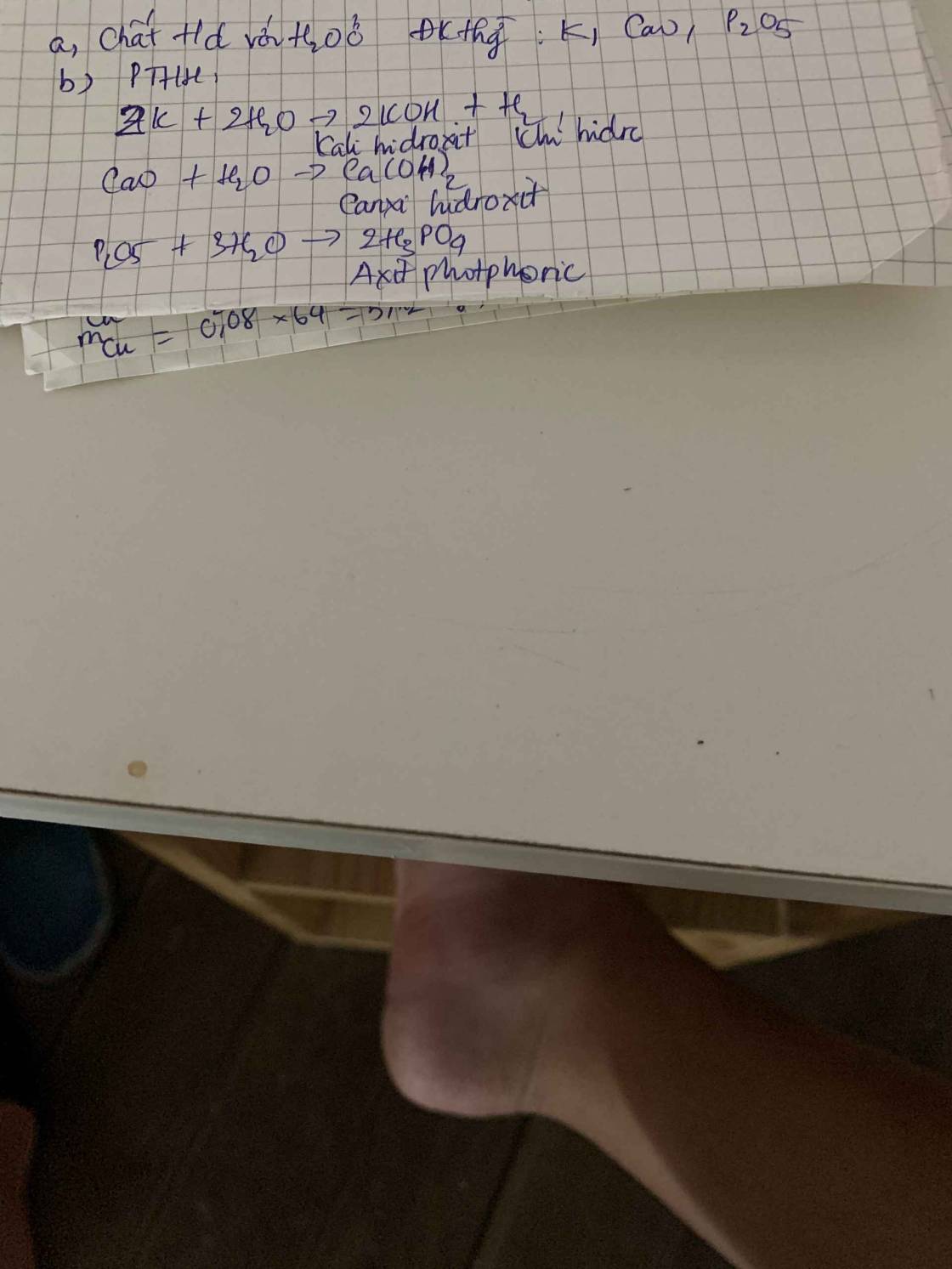Hãy nhập câu hỏi của bạn vào đây, nếu là tài khoản VIP, bạn sẽ được ưu tiên trả lời.

a. Chất tác dụng với nước ở điều kiện thường là: CaO; P2O5; K.
b. PTHH xảy ra là
CaO + H2O →→ Ca(OH)2 (Canxi hidroxit).
P2O5 + 3H2O →→ 2H3PO4 (Axit phophoric).
K + H2O →→ KOH (Kali hidroxit)

- Bazo:
NaOH: Natri hidroxit
- Axit:
HCl: Axit clohidric
- Oxit:
+ Oxit axit: CO2 - Cacbon dioxit
+ Oxit bazo: Fe3O4 - Sắt từ oxit
- Muối:
Ba(HCO3)2 : Bari hidrocacbonat

\(2KMnO_4\xrightarrow[]{t^o}K_2MnO_4+MnO_2+O_2\\ 2Fe_{\left(d\text{ư}\right)}+O_2\xrightarrow[]{t^o}2FeO\\ FeO+CO\xrightarrow[]{t^o}Fe+CO_2\\ Fe+2HCl\rightarrow FeCl_2+H_2\\ 2H_2+O_2\xrightarrow[]{t^o}2H_2O\)
\(2KMnO_4\underrightarrow{t^o}K_2MnO_4+MnO_2+O_2\)
\(Fe+\dfrac{1}{2}O_2\underrightarrow{t^o}FeO\)
\(FeO+H_2\underrightarrow{t^o}Fe+H_2O\)
\(Fe+2HCl\rightarrow FeCl_2+H_2\)
\(2H_2+O_2\underrightarrow{t^o}2H_2O\)

b.
Fe2O3 + 3H2 \(\underrightarrow{t^o}\) 2Fe + 3H2O
Fe3O4 + 4H2 \(\underrightarrow{t^o}\) 3Fe + 4H2O
c.
Na2O + H2O \(\rightarrow\) 2NaOH
2K + 2H2O \(\rightarrow\) 2KOH + H2
N2O5 + H2O \(\rightarrow\) 2HNO3
SO2 + H2O \(\rightarrow\) H2SO3
2NH3 + H2O \(\rightarrow\) (NH3)2O + H2
a.
N2 + 2O2 \(\underrightarrow{t^o}\) 2NO2
2Br2 + O2 \(\underrightarrow{t^o}\) 2Br2O
4P + 5O2 \(\underrightarrow{t^o}\) 2P2O5
S + O2 \(\underrightarrow{t^o}\) SO2
4K + O2 \(\rightarrow\) 2K2O
2Cu + O2 \(\underrightarrow{t^o}\) 2CuO
2H2 + O2 \(\underrightarrow{t^o}\) 2H2O

Điều chế oxi trong PTN:
+Hóa chất: KMnO4, KClO3, KNO3
2KMnO4 => K2MnO4 + MnO2 + O2 (pứ phân hủy)
KClO3 => KCl + 3/2 O2 (pứ phân hủy)
Oxi có thể td với kim loại:
3Fe + 2O2 => Fe3O4 (pứ hóa hợp)
2Cu + O2 => 2CuO (pứ hóa hợp)
2Mg + O2 => 2MgO (pứ hóa hợp)
4Al + 3O2 => 2Al2O3 (pứ hóa hợp)
Oxi có thể td với phi kim:
S + O2 => SO2 (pứ hóa hợp)
4P + 5O2 => 2P2O5 (pứ hóa hợp)
C + O2 => CO2 (pứ hóa hợp)

Câu 2:
a) Các chất tác dụng với nước: SO3, P2O5, K2O, BaO, K, Mn2O7
Pt: SO3 + H2O --> H2SO4
......P2O5 + 3H2O --> 2H3PO4
......K2O + H2O --> 2KOH
......BaO + H2O --> Ba(OH)2
......2K + 2H2O --> 2KOH + H2
......Mn2O7 + H2O --> 2HMnO4
b) Các chất tác dụng với H2: Mn2O7, CuO
Pt: Mn2O7 + 7H2 --to--> 2Mn + 7H2O
.....CuO + H2 --to--> Cu + H2O
c) Các chất tác dụng với O2: Ag, Fe, CH4, K
Pt: 2Ag + O2 --to--> 2AgO
......3Fe + O2 --to--> Fe3O4
......CH4 + 2O2 --to--> CO2 + 2H2O
......4K + 2O2 --to--> 2K2O
Câu 5:
Gọi CTTQ của A: CaxCyOz
Ta có: \(x:y:z=\dfrac{40}{40}:\dfrac{12}{12}:\dfrac{48}{16}=1:1:3\)
Vậy CTHH của A: CaCO3
A: CaCO3:
B: CaO
C: CO2
D: Ca(OH)2
Pt: CaCO3 --to--> CaO + CO2
...............................(B)......(C)
......CaO + H2O --> Ca(OH)2
......(B).........................(D)
......CO2 + Ca(OH)2 --> CaCO3 + H2O
.......(C)........(B)...............(A)

\(4Al+3O_2\rightarrow2Al_2O_3\)
\(2Zn+O_2\rightarrow2ZnO\)
\(3Fe+2O_2\rightarrow Fe_3O_4\)
\(2Cu+O_2\rightarrow2CuO\)
\(2Na+O_2\rightarrow Na_2O\)
\(C+O_2\rightarrow CO_2\)
\(S+O_2\rightarrow SO_2\)
\(4P+5O_2\rightarrow2P_2O_5\)
\(2CO+O_2\rightarrow2CO_2\)
\(CH_4+2O_2\rightarrow CO_2+2H_2O\)
\(2C_2H_2+5O_2\rightarrow4CO_2+2H_2O\)
\(C_2H_6O+3O_2\rightarrow2CO_2+3H_2O\)
Cho các chất sau:P,Fe,Ag,CH4,H2.Khí oxi tác dụng được với chất nào?Viết PTHH và ghi điều kiện nếu có

Khí O2 tác dụng được với P, Fe, CH4, H2.
PTHH: (1) 4P + 5O2 -to-> 2P2O5
(2) Fe + O2 -to-> Fe2O3
hoặc (2) 3Fe + 2O2 -to-> Fe3O4
(3) CH4 + 2O2 -to-> CO2 + 2H2O
(4) 2H2 + O2 -to-> 2H2O
khí oxi tác dụng với được tất cả các chất trên !
PTHH:
\(4P+5O_2-t^o->2P_2O_5\)
\(3Fe+2O_2-t^o->Fe_3O_4\)
\(4Ag+O_2-t^0->2Ag_2O\)
\(CH_4+2O_2-t^o->CO_2+2H_2O\)
\(2H_2+O_2-t^o->2H_2O\)

1.
\(2Zn+O_2\underrightarrow{^{to}}2ZnO\)
\(2H_2+O_2\underrightarrow{^{to}}2H_2O\)
\(4Al+3O_2\underrightarrow{^{to}}Al_2O_3\)
2.
\(C_3H_8+5O_2\underrightarrow{^{to}}3CO_2+4H_2O\)
\(2C_4H_{10}+13O_2\underrightarrow{^{to}}8CO_2+10H_2O\)
\(C_2H_6O+3O_2\underrightarrow{^{to}}2CO_2+3H_2O\)
\(C_2H_4O_2+2O_2\underrightarrow{^{to}}2CO_2+2H_2O\)
3.
\(3Fe+2O_2\underrightarrow{^{to}}Fe_3O_4\)Oxit sắt từ
\(C+O_2\underrightarrow{^{to}}CO_2\)Cacbon dioxit
\(2H_2+O_2\underrightarrow{^{to}}2H_2O\)Nước
\(4Al+3O_2\underrightarrow{^{to}}2Al_2O_3\)Nhôm oxit
\(4Na+O_2\underrightarrow{^{to}}Na_2O\)Natri oxit
\(S+O_2\underrightarrow{^{to}}SO_2\)Lưu huỳnh dioxit

\(C+O_2\underrightarrow{t^o}CO_2\)
\(2H_2+O_2\underrightarrow{t^o}2H_2O\)
\(4Al++3O_2\underrightarrow{t^o}2Al_2O_3\)
\(3Fe+2O_2\underrightarrow{t^o}Fe_3O_4\)
\(CH_4+2O_2\underrightarrow{t^o}CO_2+2H_2O\)
\(2CO+O_2\underrightarrow{t^o}2CO_2\)
\(4P+5O_2\underrightarrow{t^o}2P_2O_5\)
\(2Ba+O_2\underrightarrow{t^o}2BaO\)
\(C_6H_6+\dfrac{15}{2}O_2\underrightarrow{t^o}6CO_2+3H_2O\)
\(4K+O_2\underrightarrow{t^o}2K_2O\)